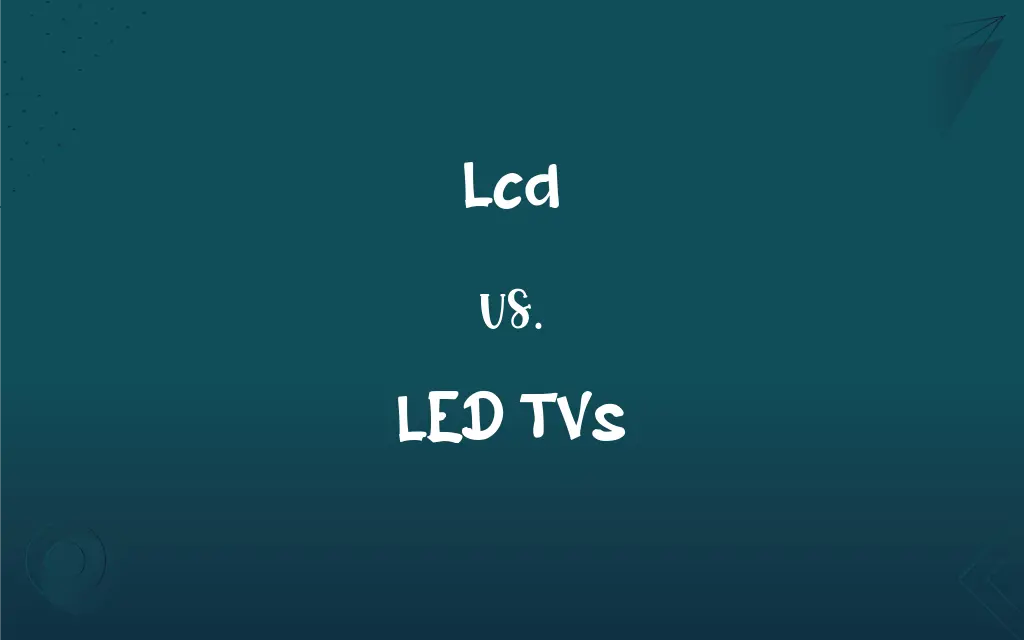LCD vs. LED TVs: What's the Difference?
Edited by Aimie Carlson || By Harlon Moss || Updated on October 20, 2023
LCD TVs use liquid crystals to produce images, while LED TVs are LCDs backlit by LEDs.

Key Differences
LCD TVs, or Liquid Crystal Display televisions, utilize liquid crystals sandwiched between two sheets of polarizing material to produce images. LED TVs, on the other hand, are essentially LCD TVs but with a different backlighting system, using Light Emitting Diodes (LEDs).
LCD TVs traditionally used Cold Cathode Fluorescent Lamps (CCFLs) for backlighting. LED TVs, as their name suggests, employ LEDs for this purpose, offering better contrast and brightness compared to standard LCDs.
Both LCD and LED TVs have their distinct advantages and drawbacks. LCD TVs tend to be more economical, but they might not offer the same picture quality as LED TVs. LED TVs often provide brighter, more vibrant images, and they are generally more energy-efficient than traditional LCDs.
When it comes to thickness and design, LED TVs usually have the edge. Because LEDs are smaller than CCFLs, LED TVs can be made much thinner than LCD TVs. This slimness is often a selling point for many consumers looking for a sleek and modern design.
While the terminology can be confusing, it's crucial to understand that all LED TVs are technically LCD TVs, but with LED backlighting. The primary distinction comes down to the backlight technology, with LED TVs being seen by many as the advanced version of LCD TVs due to their enhanced features.
ADVERTISEMENT
Comparison Chart
Backlight Technology
Cold Cathode Fluorescent Lamps (CCFLs)
Light Emitting Diodes (LEDs)
Brightness & Contrast
Typically lower than LED TVs
Generally higher due to LED backlighting
Thickness & Design
Tend to be thicker due to CCFL backlighting
Slimmer because of smaller LED lights
Energy Efficiency
Usually less energy-efficient
Typically more energy-efficient
Price
Often more economical
Might be pricier due to advanced technology
ADVERTISEMENT
LCD and LED TVs Definitions
Lcd
A tech category preceding LED in TVs and monitors.
Before buying the LED, I had an LCD for years.
LED TVs
Slim-designed televisions due to small LED lights.
The sleek design of LED TVs makes them perfect for wall-mounting.
Lcd
A display technology using liquid crystals.
My old monitor used LCD technology for its screen.
LED TVs
LCD TVs backlit by Light Emitting Diodes.
I just got a new LED TV for my living room.
Lcd
Liquid Crystal Display used in various devices.
The LCD on my digital clock recently malfunctioned.
LED TVs
Technologically advanced versions of LCD TVs.
After researching, I decided to upgrade from my LCD to LED TVs.
Lcd
A screen type that manipulates light to form images.
The LCD of my camera helps me preview the photos.
LED TVs
Advanced television sets known for vibrant displays.
LED TVs provide a better visual experience than older models.
Lcd
Display mechanism using liquid crystals between polarizers.
The broken LCD of my calculator makes it hard to read numbers.
LED TVs
Energy-efficient TVs with superior backlighting.
LED TVs consume less electricity, reducing my monthly bill.
Lcd
A digital display that uses liquid crystal cells that change reflectivity in an applied electric field; used for portable computer displays and watches etc.
FAQs
What does LCD stand for?
LCD stands for Liquid Crystal Display.
How do LED TVs differ from LCD TVs?
LED TVs are LCD TVs but with LED backlighting instead of CCFLs.
Are LED TVs more environmentally friendly than LCDs?
LED TVs are generally more environmentally friendly due to their energy efficiency and longer lifespan.
Which is more energy-efficient, LCD or LED TVs?
LED TVs are typically more energy-efficient than traditional LCDs.
Are LED TVs always thinner than LCDs?
Generally, LED TVs are slimmer due to their smaller backlighting source.
Why are LED TVs often brighter than LCDs?
LED TVs have better brightness because of the superior LED backlighting.
Can both LCD and LED TVs have 4K resolution?
Yes, both LCD and LED TVs can have 4K or even higher resolutions.
Why are LED TVs often viewed as superior to LCDs?
LED TVs offer better brightness, contrast, energy efficiency, and a slimmer design than traditional LCDs.
Is it true that all LED TVs are technically LCD TVs?
Yes, LED TVs are LCD TVs but with a different backlighting system.
Which provides better contrast, LCD or LED TVs?
LED TVs generally offer better contrast due to their backlighting.
Are LED TVs more expensive than LCDs?
Typically, LED TVs are pricier because of their advanced technology and features.
How do LCDs form images on the screen?
LCDs use liquid crystals between polarizers to manipulate light and produce images.
Do LCD TVs use more power than LED TVs?
Typically, traditional LCDs consume more power compared to LED TVs.
Which is better for brightly lit rooms, LCD or LED TVs?
LED TVs, with their superior brightness, are usually better for brightly lit rooms.
Which has a longer lifespan, LCD or LED TVs?
LED TVs usually have a longer lifespan due to the durability of LEDs.
Are there different types of LED TVs?
Yes, there are edge-lit and full-array LED TVs based on LED placement.
Can both LCD and LED TVs be mounted on walls?
Yes, both LCD and LED TVs can be wall-mounted.
Are LED TVs better for gaming than LCDs?
Often, LED TVs are preferred for gaming due to their better contrast and refresh rates.
Can LCD and LED TVs both be smart TVs?
Yes, both LCD and LED TVs can have smart features.
Do LED TVs have a faster refresh rate than LCDs?
LED TVs often have better refresh rates, but this can vary based on the model and brand.
About Author
Written by
Harlon MossHarlon is a seasoned quality moderator and accomplished content writer for Difference Wiki. An alumnus of the prestigious University of California, he earned his degree in Computer Science. Leveraging his academic background, Harlon brings a meticulous and informed perspective to his work, ensuring content accuracy and excellence.
Edited by
Aimie CarlsonAimie Carlson, holding a master's degree in English literature, is a fervent English language enthusiast. She lends her writing talents to Difference Wiki, a prominent website that specializes in comparisons, offering readers insightful analyses that both captivate and inform.































































